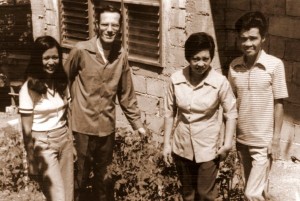Surviving a Typhoon: Roofs Flew Off Like Kites
The Franciscan friars of the Province of St. John the Baptist have been serving the people of the Philippines for over 60 years. Br. Philip Wilhelm, OFM, remembers Typhoon Yaling in 1970.
News of the Philippines seems to appear in the daily news only when there is a catastrophe. This time it is about Typhoon Haiyan, one of the worst storms that ever hit the islands of the Philippines.
I spent two years in Baybay, Leyte, which is on the west side of the mountain. Tacloban is on the east side of the mountains and was the first city to feel the impact of Haiyan. The most dangerous typhoon I witnessed, Typhoon Yaling, was in 1970 when I was stationed at the seminary in Quezon, City. I was assigned in the college building with the young seminarians when, one morning, the wind began and heavy rains blew against the windows. It was not long before three of the chapel windows were blown out and much glass covered the chapel floor. Then the large mango tree in front of the refectory was uprooted and much of it landed on the roof. Some of the seminarians and I were living on the third floor and we watched as some of the ceiling was sucked up toward the roof. The roof and some of the beams of the building were moved about four inches and set down again. I told our young boys, “We better get off this floor.” Looking out the windows we could see the roofs of some of the houses nearby flying off like kites.
Then we all were called to go and help the families, many with children, and bring them to the seminary. Thankfully, a good part of the six-foot wall around the seminary had collapsed and we were able to get out. I remember having one child in my arms and holding on to another as we walked through 2 feet of water. The wind increased as we made our way to the seminary. No one was hurt from the flying galvanized sheets used as roofs or the branches of the trees and other wood.
In the meantime the large mango tree that had landed on the refectory was blown off and crashed in the court yard. By nightfall the storm had passed over. We had damage on both buildings, and the homes around us were all damaged. We had no electricity, which meant we had no water that evening except what was in the large tank. Once that was used up we would wait until morning to get water from another source. Classrooms had space for 250 people, and we shared the food we had with them.
We would learn later that over 200 people gathered for several days at the village church which we cared for. Even so, this typhoon was small compared to what happened in Tacloban, Leyte.
---Br. Philip
Br. Philip Wilhelm, OFM, spent many years in the Philippines until last spring when he moved back to the United States. His newest assignment is at the Church of the Transfiguration in Southfield, Michigan. Read last year’s Christmas letter from the Philippines.
 By the grace of God, our missionaries in the Philippines survived Typhoon Haiyan, one of the most devastating storms in history.
By the grace of God, our missionaries in the Philippines survived Typhoon Haiyan, one of the most devastating storms in history.
But tens of thousands lost everything they own – and in many cases, everyone they love. Just as they have since 1956, our Franciscan friars will be working to support and sustain those who are most in need.
With your help and their efforts, we can give the people of the Philippines a reason to hope, and the means to rebuild. Please donate whatever you can to our relief efforts. Please remember to select “Philippines” on the drop down when asked how you would like your gift used.
Posted in: Missions, News, Prayer, Uncategorized


